The history of Beethoven’s quartet of instruments is as fascinating and complex as the personality of their owner. The story begins when Beethoven moved to Vienna in 1792 to study with Haydn. The young composer naturally turned to his teacher for support and Haydn, who was well established in upper-class Viennese circles, duly introduced him to a series of wealthy patrons. Beethoven became the protégé of Karl Alois, Prince Lichnowsky, who granted him an annual stipend of 600 florins [1] and allowed him to live at his residence for some years. [2]
Lichnowsky was a connoisseur of music and the arts. He played the piano and every Friday morning a string quartet met at his house. According to Beethoven’s friend Franz Gerhard Wegeler, the Friday morning quartet consisted of ‘four hired musicians ‒ Schuppanzigh, Weiss, Kraft and another (Link?), besides our friend [presumably Beethoven]; generally also an amateur, Zmeskall.’ [3]
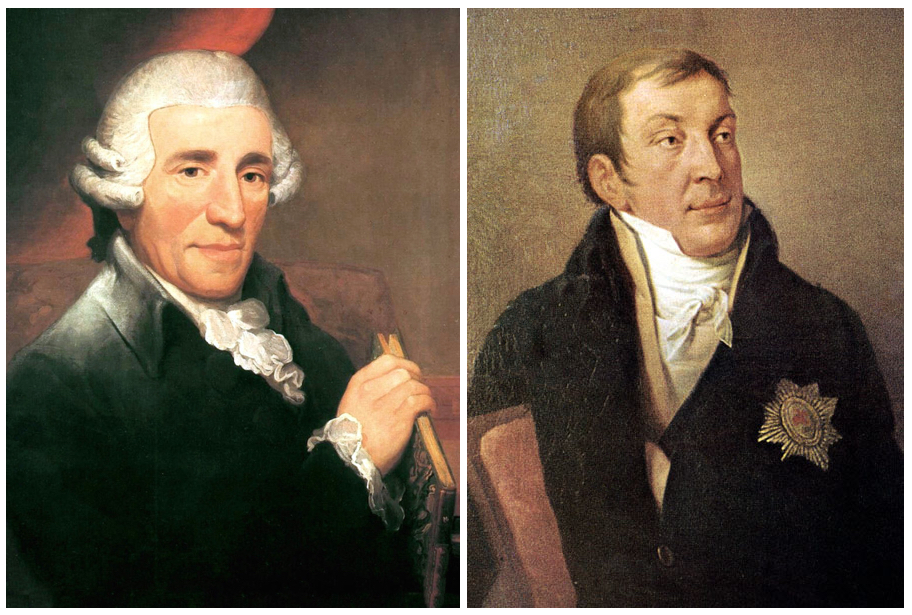
Left: Joseph Haydn by Thomas Hardy, 1791; right: Prince Lichnowsky. Images: Wikimedia Commons
Beethoven’s biographer Alexander Thayer explained the importance of this quartet: ‘They enjoyed an advantage known to no other quartet ‒ that of playing the compositions of Haydn and Förster under the eyes of the composers, and being taught by them every effect that the music was intended to produce. Each of the performers, therefore, knowing precisely the intention of the composer, acquired the difficult art of being independent and at the same time of being subordinate to the general effect. When Beethoven began to compose quartets he had, therefore, a set of performers schooled to perfection by his great predecessors, and who already had experience in his own music through his trios and quartets.’ [4]
Lichnowsky also presented Beethoven with a quartet of stringed instruments at some point. It has been suggested that this happened in 1797, [5] but in fact the first record of these instruments comes from a document known as the Heiligenstadt Testament. [6] This is a long, desperately sad letter that Beethoven wrote to his brothers Carl and Johann in October 1802. The previous winter he had moved to Heiligenstadt, then a small village outside Vienna, in an attempt to protect his failing hearing.
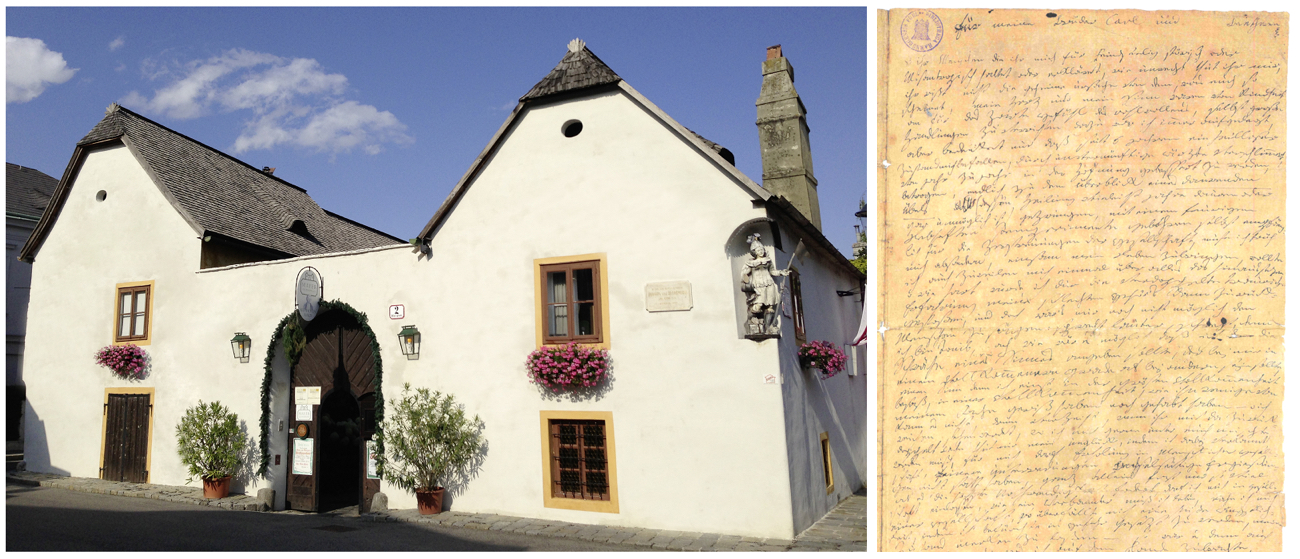
Left: the house where Beethoven lived in Heiligenstadt; right: a facsimile of the Heiligenstadt Testament, photo: Wikimedia Commons
Unfortunately, the result of this self-imposed exile was disastrous: ‘…the benefit to his hearing proved to be small or none,’ according to Thayer [7] and the composer sank into a deep depression. In the Heiligenstadt Testament, he wrote:
‘[…] for the last six years I have been afflicted with an incurable ailment, worsened by uncomprehending physicians and deceived from year to year with vain hopes of improvement. […] Farewell, and love each other. I thank all my friends, particularly Prince Lichnowsky and Professor Schmidt. I would like one of you to preserve the instruments from Prince L. in your home, but not so as to cause strife between you. As soon as you can put them to a more useful end, feel free to sell them. How happy I am to think that I can still be of service to you in my grave! ‒ That is all. […] Farewell, and do not wholly forget me when I am dead […]’ [8]
Beethoven did not send this letter, but instead kept it among his papers, where it was found after his death in 1827. [9] He does not itemize every instrument in the letter, presumably because his brothers were already aware of the quartet’s existence. The question of who made the instruments has therefore to be pieced together from other sources.
After Beethoven’s death his instruments were auctioned along with some of his other possessions on November 5, 1827. [10] The final report of this auction records four instruments, although it misspells the names of Guarneri and Rugeri as Quaneri/Quarneri and Reschner respectively: [11]

Auction report from November 1827. Sums in convention coin; column 1: estimate price; column 2: sale price
The next mention of Beethoven’s instruments comes nearly 20 years later, in an advertisement in the Wiener Zeitung from 1846, which announced that ‘Ludwig van Beethoven’s Violin’ was for sale:
‘The above mentioned has been made by Nicolo Amati from Cremona in 1667 […] The seal of Beethoven is placed backwards under the neck, and below it a large B by Beethoven’s own hand has been carved with a feather knife. Enthusiasts are kindly made aware of the fact that besides being an excellent, now so rare, genuine Cremonese Amati violin, it also has the advantage of having been the property and favourite instrument of the greatest musician of all time…’ [12]
The news caused a small sensation. Within a week Aloys Fuchs, Member of the Imperial-Royal Court Chapel, published a reply in the Allgemeine Wiener Musik-Zeitung:
‘In the Wiener Zeitung of November 21 of this year, a violin was offered for sale which once belonged to the great L. v. Beethoven. Since this note was also taken up by other local journals, and many remarks were made to follow which one might assume that this violin would have been the only instrument owned by Beethoven, I find myself prompted to make the following statement.
‘Ludwig van Beethoven possessed a complete string quartet of excellent instruments by Italian masters, which was made a gift to him by his princely patron and friend Lichnowsky at the instigation of the famous quartet player Schuppanzigh. I am able to describe these instruments in more detail.
‘1) A violin by Jos. Guarnerius made in Cremona in 1718; currently in the possession of Mr. Carl Holz, director of the Konzerts Spirituels in Vienna;
2) The 2nd violin (the one offered for sale) is made by Nikolaus Amati in 1667 and was in the possession of Dr. Ohmeyer, who died recently in Hütteldorf, has now been purchased by Mr. Huber.
3) The viola made by Vincenzo Ruger in 1690 is also the property of Mr. Carl Holz.
4) The violoncello, an Andreas Guarnerius from 1712, is currently in the possession of Mr. P. Wertheimber in Vienna.
‘On all instruments the seal of Beethoven is imprinted under the neck, and on the so-called bottom of the same a large B of Beethoven’s own hand is scratched into it; probably the great master intended to protect himself from an exchange. The instruments are well preserved and in good condition.
‘The most valuable one is undoubtedly the violin by Ioseph Guarnerius, distinguished by a rare power of tone […]’ [13]
Fuchs’s detailed description of the instruments appears authoritative, especially as the violinist Karl Holz was a friend of Beethoven and a member of Ignaz Schuppanzigh’s string quartet. However, a closer analysis shows a couple of inconsistencies. Fuchs dated the cello as a work of Andrea Guarneri from 1712, but Guarneri died in 1698. Also, in the 1827 auction of Beethoven’s instruments the cello was described as a work of ‘Peter’ not Andrea Guarneri.
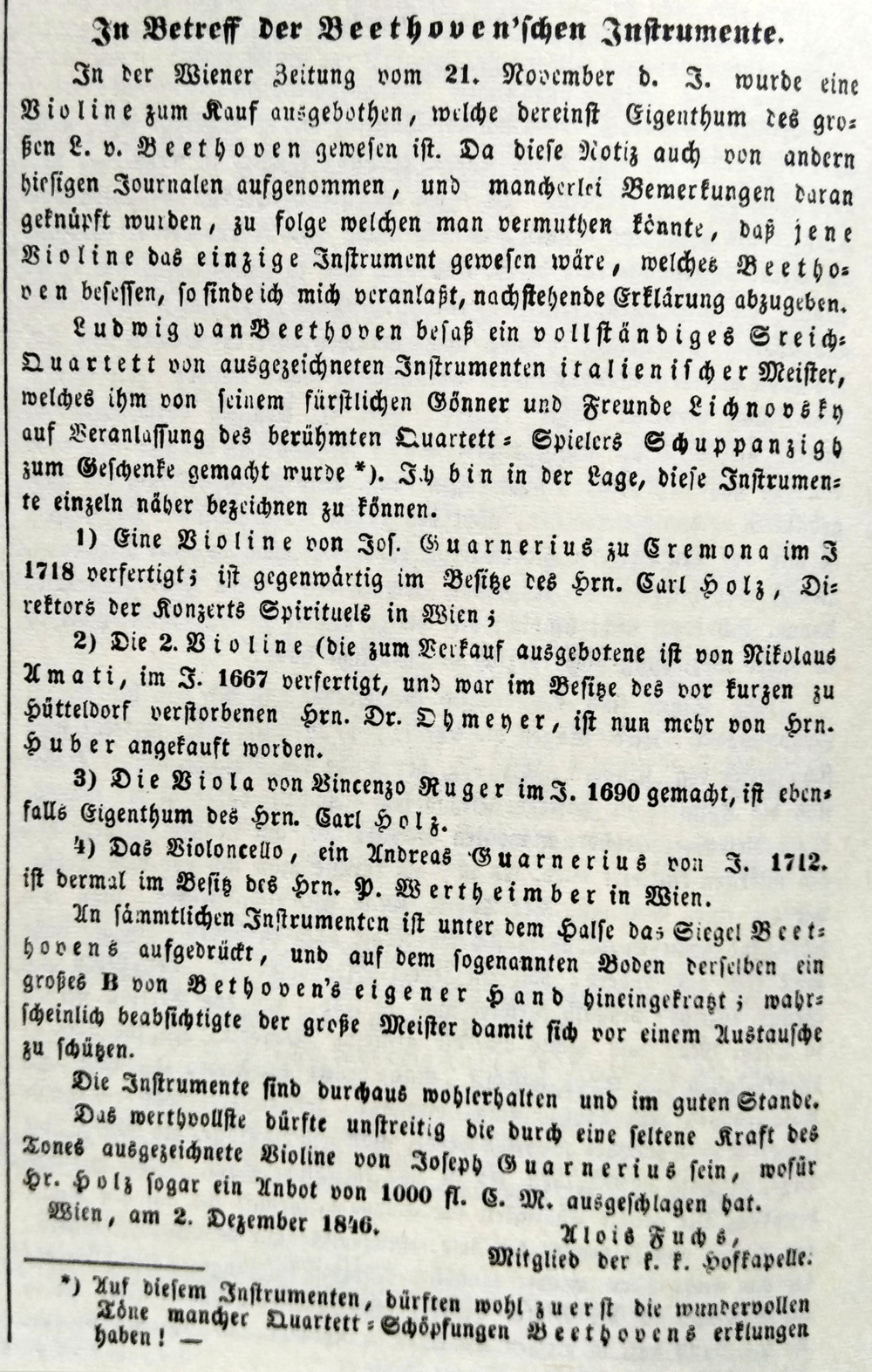
The response published by Aloys Fuchs in the Allgemeine Wiener Musik-Zeitung of 1846, giving details of Beethoven’s quartet. Photo: Alessandra Barabaschi, reproduced by permission of Georg Olms Verlag
Perhaps it was Fuchs’ announcement that aroused the interest of the art dealer and music publisher Carl Gotthelf Böhme, who decided to buy the four instruments and reunite them as a quartet. He did not buy them all at once, but methodically, almost one per year. The ‘Rugeri’ viola and the ‘Guarneri’ violin were acquired from Holz (in November 1851 [14] and December 1852 [15] respectively), who provided Böhme with a written confirmation that these two instruments were part of the Lichnowsky set. In December 1853 Böhme got hold of an ‘Amati’ violin dated 1690. [16] The music lover Franz Nappenbach was recorded by Holz as last owner of the instrument and it was probably he who sold the violin to Böhme. Finally he bought the ‘Guarneri’ cello, again from Holz, in April 1855. [17]
Shortly after Böhme’s death [18] all four instruments were bought by Peter Jokits [19] for about 8,000 Thaler. [20] Jokits was a ‘Serbian-born Viennese wholesaler’ [21] of ‘Turkish goods’, [22] who presented the quartet to the German Emperor Wilhelm I and was decorated with the Order of the Red Eagle (3rd Class) in return. The instruments, as part of the Jokits Foundation, arrived in Berlin in October 1861 and were brought to the former Royal Library, now the Berlin State Library.
In 1889 Emperor Wilhelm II ordered that Beethoven’s quartet should be handed over to the Hochschule für Musik in Berlin, the music institute directed by Joseph Joachim. The Beethoven-Haus society, which was founded in Bonn that same year, [23] sent a request to Joachim expressing the desire to exhibit the instruments in 1890 and again in 1893. Permission was granted on these and several other occasions, with the result that the instruments commuted between Berlin and Bonn until 1969, when they were granted to the Beethoven-Haus on permanent loan. [24]
If we compare the four instruments that were acquired by Böhme, and subsequently by Jokits, with the list of the ‘Lichnowsky instruments’ made by Fuchs in 1846, some discrepancies are noticeable.
The Lichnowsky set presented to Beethoven (Fuchs)
|
The Jokits Foundation instruments
|
The provenance (Karl Holz) and the presence of Beethoven’s seal [25] and the scratched ‘B’ are consistent in both the ‘Guarneri’ violin and the ‘Rugeri’ viola. These were the only two instruments that were described by Holz as belonging to the Lichnowsky set. [26]
In the case of the ‘Amati’ violin, according to Holz this instrument belonged to Ignaz Schuppanzigh already by 1826 and was sold by him to Nappenbach a short time later. [27] Therefore this cannot be the violin that was described by Fuchs as owned by Dr Ohmeyer and Mr Huber. Moreover, Fuchs declared that the best violin of the set was the ‘Guarneri’, but when the Guarneri is compared with the 1690 Amati violin in Bonn, this is not the case. [28]
Compared with the set recorded by Fuchs, the ‘Amati’ violin and the ‘Guarneri’ cello in Bonn differ in three details out of four: the date on the label, the provenance and the characteristics (in both cases Beethoven’s seal is missing).
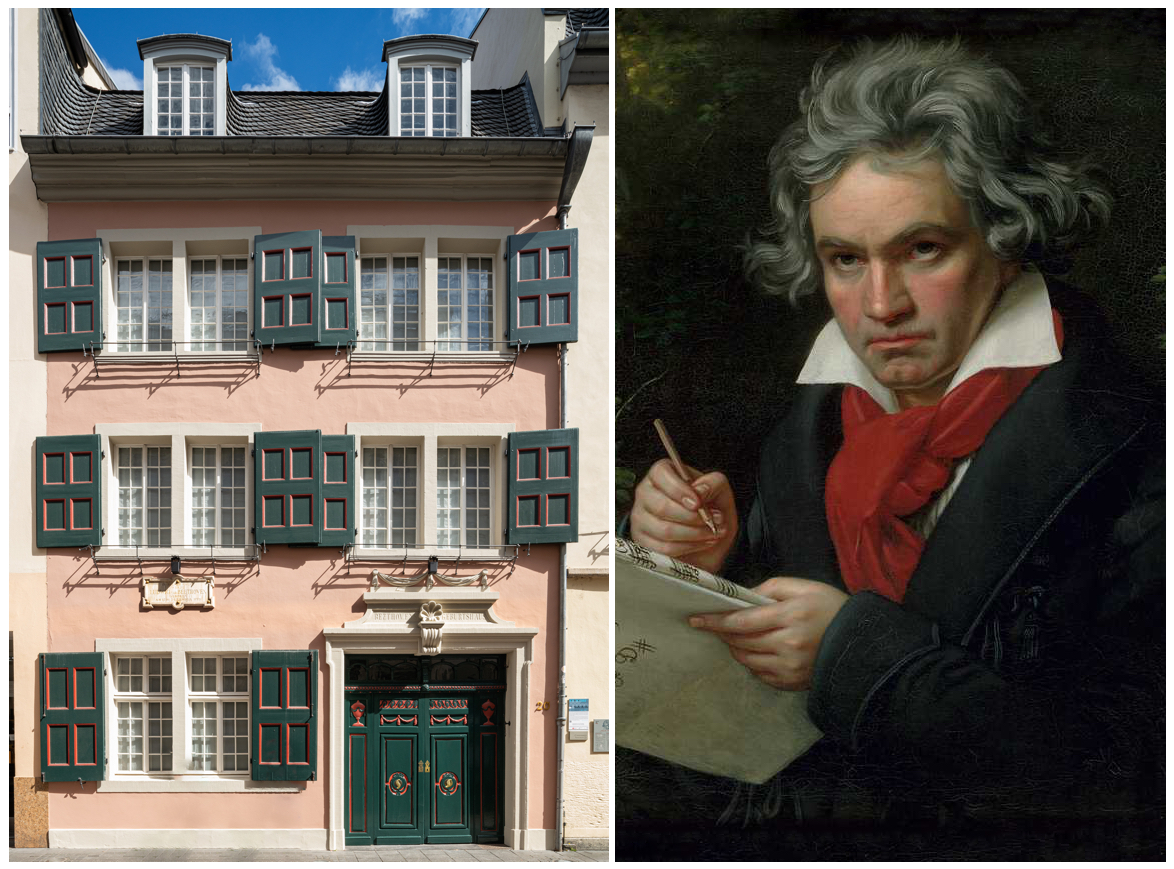
Left: the facade of the Beethoven-Haus museum; right: portrait of Beethoven by Joseph Karl Stieler, 1820. Photos: courtesy Beethoven-Haus Bonn
In 1996 the Beethoven-Haus acquired another violin carrying a fake Amati label dated 1676, which has both Beethoven’s seal and a large ‘B’ scratched by his own hand. [29] It is a good instrument but, as in Fuchs’ description, its manufacture is inferior to the ‘Guarneri’ violin. Could this be the ‘Amati’ from Fuchs’ list? Fuchs mentions an Amati label dated 1667, but it is possible that he transposed the digits or simply copied it from the previous advertisement, where the violin was also dated 1667. Apart from this detail, this second ‘Amati’ violin of the Beethoven-Haus, which has now joined the other four instruments in Bonn, seems to fit Fuchs’ description.
The case of the ‘Guarneri’ cello is slightly different. A list of the instruments in a letter from the Prussian envoy to the Prussian Foreign Minister in 1861 gives the cello’s date as 1712, matching Fuchs’ description. [30] However, by the time the instruments were sent to Bonn in 1893, as mentioned above, the cello is recorded as 1675. [31] Was the date changed because someone realized that Andrea Guarneri died before 1712? Even if this is the case, there is still the problem that the 1675 cello lacks Beethoven’s seal. Kai Köpp suggests that this cello was not actually part of the set that Lichnowsky presented to Beethoven, [32] although it does appear to have belonged to the composer at some point. [33]
A short time ago another cello was found which has both a fake label that reads: ‘Petrus Guarnerius Cremonensis fecit Anno 1712’ and two of Beethoven’s seals (but no scratched ‘B’). This instrument appears to have belonged to the Lichnowsky set, the instrument described as ‘Peter Quaneri’ in the final report of the 1827 auction and exhibited in Vienna in 1927. [34] It currently belongs to a private owner who has agreed to have it exhibited in the Beethoven-Haus. The whole quartet has thus been reunited in Bonn.
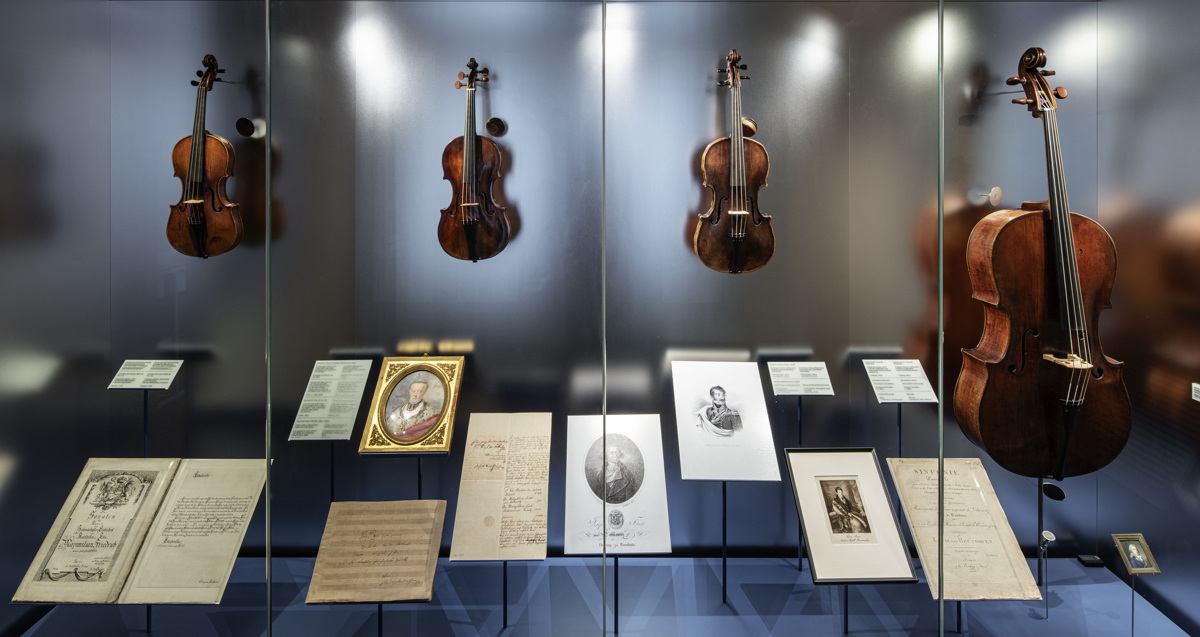
Beethoven’s quartet exhibited at the Beethoven-Haus museum. This is the set believed to have been presented to him by Prince Lichnowsky. Photo: David Ertl, courtesy Beethoven-Haus Bonn
It therefore appears that Beethoven owned at least six string instruments: three violins, one viola and two cellos. The provenance of the additional violin and cello is still unknown. Did Beethoven buy them himself or were they also given to him? And if so, by whom and when? We may never know.
The provenance of the additional violin and cello is still unknown. Did Beethoven buy them himself or were they also given to him?
During the 20th century the labels of the Lichnowsky set were proven to be forgeries. The violin labeled Guarneri 1718 is now thought to be from the second half of the 18th century, although experts have disagreed about its country of origin. [35] [36] The violin labeled Amati 1676 is considered to be of the German school, also from the second half of the 18th century. [37] Meanwhile the Rugeri-labeled viola has been ascribed to Johann Anton Gedler [38] and the 1712 Guarneri cello lacks a definite attribution.
Regardless of their attributions, from a historical point of view these instruments are priceless because they formed part of Beethoven’s vital hand tools. They were used to create new compositions that would change the history of music forever. When Beethoven was facing one of his worst phases, in Heiligenstadt in 1802, he sought refuge in one positive thought, one glimpse of hope, which was provided to him by his quartet, a present from his friend Prince Lichnowsky.
Thanks to the Beethoven-Haus, Bonn (Prof. Siegert; Dr Ronge; Stefanie Kuban), the State Institute for Music Research, Berlin (Carsten Schmidt), the Hamburg State and University Library Carl von Ossietzky, and the Carducci String Quartet.
Original German texts translated by Alessandra Barabaschi.
Alessandra Barabaschi is an Italian art historian and has authored several books including the four-volume ‘Antonius Stradivarius’.
Notes
[1] Beethoven, Ludwig van, Letter no. 65 to Franz Gerhard Wegeler, Vienna, June 29, 1801, in: Brandenburg, Sieghard [ed.], Briefwechsel Gesamtausgabe, vol. 1, G. Henle Verlag, Munich, 1996, p. 79.
[2] Beethoven’s friend Wegeler recorded that he found Beethoven living at the prince’s residence when he reached Vienna at the end of 1794. He was still there when Wegeler left the city in the middle of 1796. Wegeler, Franz Gerhard; Ries, Ferdinand, Biographische Notizen über Ludwig van Beethoven, Georg Olms Verlag, Hildesheim, Zurich/New York, 2000, p. 28.
[3] Ibid., p. 29.
[4] Thayer, Alexander Wheelock, The life of Ludwig van Beethoven, revised from the German editions of Hermann Deiters and Hugo Riemann; documents translated by Henry Edward Krehbiel, vol. 1, The Beethoven Association, New York, 1921, p. 237.
[5] Thayer, Alexander Wheelock, Beethoven’s Instrumente Letter to Mr Krehbiel, ed. Musical Courier, reproduced in: Allgemeine Musikzeitung, vol. 15, no. 27, Berlin, 1888, p. 269.
[6] The Heiligenstadt Testament is preserved in the Hamburg State and University Library Carl von Ossietzky.
[7] Thayer, A. W., The life of Ludwig van Beethoven, op. cit., p. 351.
[8] Beethoven, Ludwig van, Heiligenstädter Testament, ed. Sieghard Brandenburd, Verlag Beethoven-Haus, Bonn, 1997, pp. 11-13.
[9] The Heiligenstadt Testament was published in October 1827: Beethoven, Ludwig van, ‘Für meinen Bruder Karl und *** Beethoven mp’, Allgemeine Musikalische Zeitung, vol. 29, no. 42, Breitkopf & Härtel, Leipzig, October 17, 1827, pp. 705–710.
[10] Jäger-Sunstenau, Hanns, ‘Beethoven-Akten im Wiener Landesarchiv’, article featured in: Beethoven-Studien: Festgabe der österreichischen Akademie der Wissenschaften zum 200. Geburtstag von Ludwig van Beethoven, vol. 11, Hermann Böhlaus Nachf., Vienna, 1970, p. 25.
[11] Ibid., p. 29.
[12] Zu verkaufen Ludwig van Beethovens Violine, advertisement #16862, Wiener Zeitung, Vienna, Nov 21, 1846, p. 27 marked as 677.
[13] Fuchs, Alois, ‘In Betreff der Beethoven’schen Instrumente’, Allgemeine Wiener Musik-Zeitung, no. 146/147, Vienna, Dec 5, 1846, p. 594. A second, shorter announcement, appeared under: ‘Feuilleton’, in: Allgemeine musikalische Zeitung, no. 2, Leipzig, Jan 13, 1847, p. 30.
[14] Folio 11–12, transaction #113, document belonging to the Jokits Foundation (Jokits-Stiftung). Kindly provided by the State Institute for Music Research, Berlin.
[15] Folio 9-10, transaction #112, Jokits Foundation, op. cit.
[16] Folio 7-8, transaction #112, Jokits Foundation, op. cit.
[17] Folio 13, transaction #112, Jokits Foundation, op. cit.
[18] Köpp, Kai, ‘Beethovens Violoncello – Ein Geschenk des Fürsten Lichnowsky? – Zur Provenienz der Streichquartettinstrumente Beethovens’, article in: Beethovens Werke für Klavier und Violoncello, Schriften zur Beethoven-Forschung, vol. 15, ed. Sieghard Brandendurg, Ingeborg Maass, Wolfgang Osthoff, Verlag Beethoven-Haus, Bonn, 2004, p. 317.
[19] ‘Tages- und Unterhaltungs-Blatt, Berlin’, Niederrheinische Musik-Zeitung für Kunstfreunde und Künstler, vol. 9, no. 38, Cologne, Sept 21, 1861, p. 303.
[20] Jokits, Wolfgang, ‘Beethoven’s Streichinstrumente’, Neue freie Presse, no. 8563, Vienna, June 27, 1888, p. 2.
[21] Wege zur Musik, Staatliches Institut für Musikforschung, Preußischer Kulturbesitz, Berlin, 1984, p. 26.
[22] Ullrich, Hermann, ‘Karl Holz: Beethoven letzter Freund: eine Studie’, in: Studie zur Musikwissenschaft, vol. 31, Hans Schneider, Tutzing, 1980, p. 162.
[23] Schmidt, Ferdinand August; ed. Sonnenburg, P.E., Führer durch das Beethoven-Haus zu Bonn, Verlag Beethoven-Haus, Bonn, c. 1893, p. IV.
[24] The four instruments belong to the Musikinstrumenten-Museum des Staatlichen Instituts für Musikforschung Preußischer Kulturbesitz in Berlin.
[25] Beethoven owned at least two seals with his initial. He used to call the big one his ‘state seal’, as recorded in: Schindler, Anton, Biographie von Ludwig van Beethoven, vol. 1, 3rd edition, Aschendorff, Münster, 1860, p. 373.
[26] Folio 11-12 for the ‘Rugeri’ viola and folio 9-10 for the ‘Guarneri’ violin, Jokits Foundation, op. cit.
[27] Holz, Karl, letter to Böhme, 1890, Folio 7–8, Jokits Foundation, op. cit.
[28] Köpp, K., Beethovens Violoncello, op. cit., p. 315.
[29] Köpp, K., ‘Beethovens Geige wieder entdeckt’, Appasionato, no. 17, Verlag Beethoven-Haus, Bonn, Nov 2006, p. 1-2.
[30] Letter from the Prussian envoy von Werther to the Prussian Foreign Minister Baron von Schleinitz, May 3, 1861, in: Köpp, K., Beethovens Violoncello, op. cit., p. 332.
[31] Letter from Wilhelm Kuppe, member of the Beethoven-Haus society, Berlin, Feb 4, 1893. Kindly provided by the State Institute for Music Research, Berlin.
[32] Köpp, K., Beethovens Violoncello, op. cit., p. 340.
[33] This cello is still preserved in Bonn.
[34] Führer durch die Beethoven-Zentenarausstellung der Stadt Wien: Beethoven und die Wiener Kultur seiner Zeit; Catalogue of the exhibition in Vienna, 1927, Selbstverlag der Gemeinde Wien, Vienna, 1927, p. 89.
[35] Otto Möckel believed it to be either a work of Pietro Antonio Landolfi or a Dutch work from the workshop of Johannes Theodorus Cuijpers. Certificate dated April 26, 1931, mentioned in: Otto, Irmgard; Adelmann, Olga, Staatliches Institut für Musikforschung, Musikinstrumenten-Meseum Berlin, Katalog der Streichinstrumente, Berlin, 1975, p. 158.
[36] Rudolf Pliverics examined the violin in 1968 and considered it neither an Italian nor a Dutch work, but a very good instrument nevertheless. Reference in: Schiegnitz, Thomas, ‘Beethovens Quartett’, in: Das Musikinstrument, vol. 48, Bergkirchen, April 1999, p. 52.
[37] According to Michael Baumgartner the classification as ‘Southern German’ is unlikely. The body has greater affinity to the works of Johann Schorn (Salzburg).
[38] Otto, I.; Adelmann, O., Staatliches Institut für Musikforschung, op. cit., p. 234.